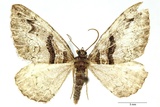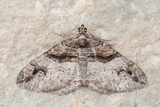Pareulype berberata ([Denis & Schiffermüller], 1775) Species
Last modified: Nov. 8, 2025, 2:47 p.m.
A not so common and local species in Belgium. Formerly known only from the southern part, but since 1980 spread over almost the whole country together with its foodplant which is planted in gardens.
This species is considered Endangered according to the IUCN Red List category for Flanders 2023.
Details
- Classification
- Family: Geometridae > Subfamily: Larentiinae > Tribus: Rheumapterini > Genus: Pareulype > Species: Pareulype berberata
- Vernacular names
- Berberisspanner (NL), Barberry Carpet (EN), La Phalène de l'Epine-Vinette (FR), Kleiner Berberitzenspanner (DE)
- First mention in Belgium
- De Sélys-Longchamps E. 1844. Énumération des insectes Lépidoptères de la Belgique. — Mémoires de la Société royale des Sciences de Liége 2: 1–35. On page 17 (as Cidaria berberaria). view page
- Status
-
Native
Distribution
Bionomics
Hibernates as pupa in a loose cocoon, often among plant debris but usually deeper under the ground.
They are active from dusk onwards and later come to light.
No pictures yet!
Flight periods
The adults fly in two generations a year in May and June and again in August.
Observed on
- Host plant (species):
- Berberis vulgaris
The larva lives on Berberis vulgaris, but also on cultivated plants.
No pictures yet!





